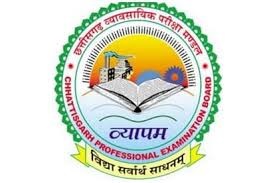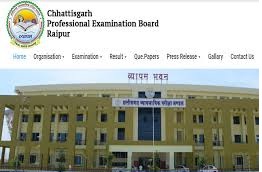Chhattisgarh Professional Examination Board Question Paper TET Exam : vyapam.cgstate.gov.in
Organisation : Chhattisgarh Professional Examination Board
Exam Name : TET Examination
Document Type : Question Paper
Year : 2024
Website : https://vyapam.cgstate.gov.in/node/776
Chhattisgarh TET Examination Question Paper
1. Who said? “Adolescence is a period of great stress and strain, storm and strike”.
A. Crow and Crow
B. Stanley Hall
C. Hunt
D. Simpson
Related / Similar Question Paper : Chhattisgarh Professional Examination Board Question Paper SET Exam

2. Pre-operational phase of cognitive development is-
A. More than 11 years
B. From 7 to 11 years
C. From 2 to 7 years
D. Upto 2 years from birth
3. Reasoning, Curiosity and Observation are developed at the age of-
A. 7 year
B. 6 year
C. 9 year
D. 11 year
4. Formulated theory by J. Piaget is-
A. Cognitive development
B. Motor development
C. Social development
D. Physical development
5. Whose statement is this? “The scope and intensity of learning during infancy exceeds that of any other period of development”.
A. Watson
B. Skinner
C. Freud
D. Adler
6. Which is not included in the process of development in Adolescence?
A. Physical development
B. Mental development
C. Language development
D. Emotional development
7. Development of Child starts-
A. By Birth
B. Before Birth
C. In pregnancy
D. Before pregnancy
8. Who is the father of Personal Psychology?
A. Freud
B. Adler
C. Hurlock
D. Yung
9. “Development results in new characteristics and new abilities on the part of Individual”. This statement is given by-
A. Hurlock’s
B. Freemen’s
C. Cattell’s
D. Woodworth’s
10. Which one is not a projected method?
A. Rorschach Test
B. Thematic Apperception Test
C. Children Apperception Test
D. Stanford-Binet Test
11. Social determinants include all the following, except-
A. Family relationship
B. Birth order
C. Neighbourhood
D. People’s behaviour
12. To which stage, Emotional Functional game is related-
A. Infancy’s
B. Childhood’s
C. Adolescent’s
D. Youth’s
13. Quantitative and qualitative aspects are include in-
A. In intelligence
B. In development
C. In family
D. In community
14. The gland, which influence the Physical Development is-
A. Adrenal
B. Thymus
C. Pineal
D. Pituitary
15. According to Jean Piaget, which of the following is necessary for learning?
A. Active exploration of the environment by the Learner
B. Observing the behaviour of adults
C. Belief in immanent justice
D. Reinforcement by teachers & parents
16. “Children actively construct their understanding of the world” is a statement attributed to-
A. Kohlberg
B. Skinner
C. Piaget
D. Pavlov
17. Which of the following is not a component of cognition?
A. Feelings
B. Thoughts
C. Attention
D. Perception
18. Children with special needs get a better education in regular school than in a special school because, there is-
A. No gender discrimination
B. Equity and equality
C. Competition with normal students
D. Good Cooperation
19. Adolescence is the period of-
A. 5-10 years
B. 11-19 years
C. 22-28 years
D. 30-40 years
20. Which of the following is example of Innate Motive?
A. Award
B. Hunger
C. Punishment
D. Incentives
21. Which of the following factors hinders successful inclusion of students with locomotor disabilities?
A. Flexible curriculum
B. Inaccessible infrastructure
C. Empathetic attitude
D. More than one of the above
22. A student enjoys learning the guitar and derives satisfaction in spite of long hours of practice. The student is-
A. Trying to please his teacher
B. Competing with others for praise
C. Intrinsically motivated
D. None of the above
23. Development occurs in human beings-
A. Upto the end of adolescence period
B. Upto the end of childhood
C. Upto the starting of adulthood
D. Throughout the life
24. To cater to children from disadvantaged backgrounds, a teacher should-
A. Try to find out more about them and involve them in class discussion
B. Make them sit separately in the class
C. Ignore them as they cannot interact with other students
D. Give them a lot of written work
25. Arrange the steps of curriculum adaptation process-
(a) Determine need for curricular adaptations.
(b) Identify elements requiring adaptation.
(c) Implement curricular adaptations.
(d) Select teaching and behaviour management techniques.
A. (a)→ (b)→ (d)→ (c)
B. (a)→ (b)→ (c)→ (d)
C. (c)→ (a)→ (b)→ (d)
D. (d)→ (b)→ (c)→ (a)
Instruction To Candidates for TET Exam
1. Immediately after getting the booklet read instructions carefully, mentioned on the front and back page of the question booklet and do not open the seal given on the question booklet, unless asked by the invigilator.
2. Write your Roll No., Answer Sheet No., in the specified places given above and put your signature.
3. Make all entries in the OMR Answer Sheet as per the given instructions otherwise Answer-Sheet will not be evaluated.
4. Along with this question booklet three barcode stickers are provided. Paste them carefully at the space provided at this question booklet, OMR sheet and attendance sheet.
5. After Opening the seal, ensure that the Question booklet contains total no. of pages as mentioned above and printing of all the 150 questions is proper. If any discrepancy is found, inform the invigilator within 15 minutes and get the correct booklet.
6. While answering the question from the question Booklet, for each question choose the correct/most appropriate option out of four options given, as answer and darken the circle provided against that option in the OMR Answer sheet, bearing the same serial number of the question. Darken the circle only with Black or Blue ball point pen.
7. Darken the circle of correct answer properly otherwise answers will not be evaluated. The candidate will be fully responsible for it.
8. There are 150 objective type questions in this question booklet. All questions are compulsory and carry 01 mark each.
9. No negative marking will be done.
10. Do not write anything anywhere in the Question booklet and the Answer-Sheet except making entries in the specified places otherwise OMR sheet will not be evaluated.
11. After completion of the examination, only OMR Answer Sheet and cover page of question booklet is to be handed over to the invigilator. Carbon copy of the Answer-Sheet and Question Booklet may be taken away by the examinee.
12. In case of any ambiguity in Hindi / English version the English version shall be considered authentic.
13. Details about Parts/Subject containing in this Question paper are given on the last page.
Scheme of TET Examination
Paper I :
Details of Parts/Subjects :
Part | Particular | No. of Questions | Marks
First Child Development and Pedagogy 30 30
Second Hindi 30 30
Third English 30 30
Fourth Mathematic 30 30
Five Environmental Studies 30 30
Paper II :
Part | Particular | No. of Questions | Marks
First Child Development and Pedagogy 30 30
Second Hindi 30 30
Third English 30 30
Fourth (A) Mathematic and Science (B) Social Science 60 60
Note :
1. This question booklet contains four Section.
2. Each question contains 01 marks. All question are compulsory.
3. Indicate your answers on the OMR Answer-Sheet provided.
4. No negative marking will be done.
5. Use of any type of calculator or log table and mobile phone is prohibited.
6. While using OMR Answer-Sheet care should be taken so that the Answer-Sheet does not get torn or spoiled due to folds or wrinkles.

Download Question Paper
Question Paper Of TET Examination – 2024
Paper I : https://www.pdfquestion.in/uploads/pdf2024/42482-1.pdf
Paper II : https://www.pdfquestion.in/uploads/pdf2024/42482-2.pdf